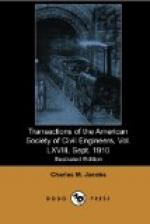There will be 21 standing-tracks at the station, and 11 passenger platforms, providing 21,500 ft. of platform adjacent to passenger trains. Within the station area, which from Tenth Avenue to the normal tunnel sections east of Seventh Avenue comprises 28 acres, there will be a total of about 16 miles of track.
The service plant for the installation of machinery for lighting, heating, and ventilating the station, and for operating the interlocking system, is located in an independent building south of the station.
The Power-House to supply the electrical energy for the operation of the tunnel line and the Long Island Railroad is situated on property in Queens Borough adjoining the present Long Island Railroad Station near the East River, and was constructed under the Chief Engineer of Electric Traction and Station Construction. As at present designed, the dimensions of the structure are 200 ft. by 262 ft., outside measurement. It can accommodate six generating units of 5,500 kw., the standard adopted for future work, and two of 2,500 kw. for lighting the tunnels. The ultimate capacity of this station when extended will be about 105,000 kw.
East River Division.—Chief Engineer, Mr. Alfred Noble.
This Division begins at the eastern limits of the New York Station at a point in 32d Street, 292 ft. east of the west line of Seventh Avenue, and at a point in 33d Street, 502 ft. east of the west line of Seventh Avenue, and also includes the excavation work and retaining walls for the station site and yard, to the track level, westward to Ninth Avenue. It extends eastward from the station under 32d and 33d Streets through tunnels partly three-track and partly so-called twin tunnels to Second Avenue; thence the line curves to the left under private property to permanent shafts a few feet east of First Avenue. Four single-track, cast-iron, concrete-lined tunnels, with outside diameters of 23 ft., pass under the East River, and, after passing through permanent shafts near the bulkhead line, reach the surface in Long Island City from 3,000 to 4,200 ft. east of the East River. The tunnel portals are in Sunnyside Yard, which extends to Woodside, the easterly end of the Division, and the Yard grading with its buildings and a number of City viaducts crossing it were executed under this Division. The total length of the Division is 4.48 miles.
The total length of the entire line is 13.66 miles. There are 6.78 miles of single-track tube tunnels, and the average length of the tunnels between portals is 5.56 miles.
[Illustration: PLATE II.—Pennsylvania Tunnel and Terminal Railroad. Map and Profile. Harrison Yard to Bergen Hill Tunnel. Meadow Division July 30 1909]
GENERAL CONSIDERATIONS.
Details have been omitted from the foregoing description, as they can be treated better and more fully by the constructing engineers in succeeding papers. There are, however, some general considerations involved in the designing of the work, which may, perhaps, be referred to more conveniently in this introductory paper, and these will now receive attention.




